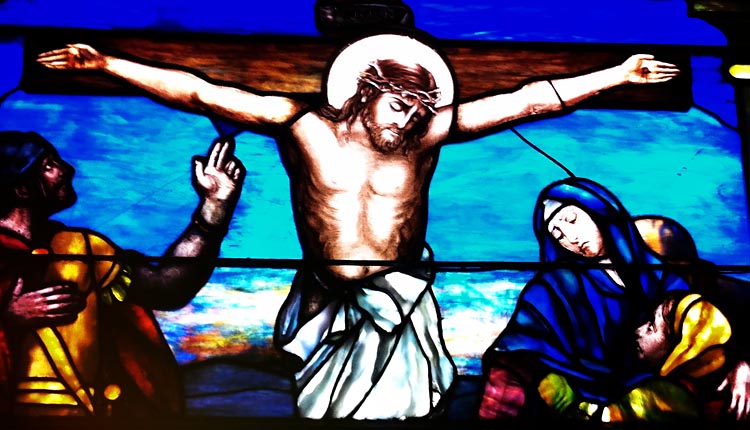“Were You There?”
by Worth Green, Th.M., D.Min.
Romans 6:3-5, Galatians 2:20
We have come to the end of a long journey. I double-triple promise that this is the last sermon in the series, “Faces Around the Cross.” We have talked about the soldiers, and the clergy. We have talked about good guys and bad. We have talked about Mary Magdalene, “The Apostle to the Apostles, ” and “the Beloved Disciple.” We have talked about, “his mother,” that is, the Mother of Jesus; and, last week, we talked about “the Unseen Presence.” On Trinity Sunday we saw that God the Father, and God the Holy Spirit were active with God the Son in the death of Jesus the Messiah on the cross, which the One Triune God used to accomplish the Atonement or At-One-Ment between God’s Self and Humankind.
Now today I want to ask a question, “Were You There?” And, as you might expect, it is a rhetorical question, because I wish to establish that in a theological sense you were indeed there, and I was right there with you.
Some of you will remember the Name of the Rev. Dr. Craig Atwood. Craig taught at Salem, and Wake Forest, and now teaches at Moravian Theological Seminary. One of his books is entitled, “The Community of the Cross.” It is well worth reading, but today, I wish simply to call your attention to the art from the back cover of that book. It is a reproduction of a painting by an unknown artist entitled, “The Crucifixion of the Savior with Herrnhut Brothers and Sisters.” Herrnhut is the little village on the estate of Count Zinzendorf where the Ancient Unity of the Moravian Church was renewed. The artist has painted Jesus on his cross as he has been painted 1,000 times before, but this painting is different. When we look for the faces around the cross that have become familiar to us over the course of this series, they are not there. Instead, the artist has painted in the faces and figures of his brothers and sisters then living in Herrnhut.
Last week I spoke with Craig by email. I thanked him for his book, and I told him I thought the painting on the back cover (and on the title page) of his book was a perfect expression of St. Paul’s theology.
In Romans 6:3-5 the apostle writes:
3 Do you not know that all of us who have been baptized into Christ Jesus were baptized into his death? 4 We were buried therefore with him by baptism into death, so that as Christ was raised from the dead by the glory of the Father, we too might walk in newness of life. 5 For if we have been united with him in a death like his, we shall certainly be united with him in a resurrection like his. Romans 6:3-5
And in Galatians 2:20 he waxes even more specific and personal. There he writes:
“I have been crucified with Christ; it is no longer I who live, but Christ who lives in me; and the life I now live in the flesh I live by faith in the Son of God, who loved me and gave himself for me.” Galatians 2:20
If I understand Paul correctly, then theologically, you and I were there, in union with Jesus, who was actually on the cross. After all, he is the head of the body, which is the church, and we are a part of his body. Jesus was not crucified without his body.
Now some will think this an impossible statement. They will point out that Jesus was crucified more than 1980 years ago, and that the oldest person here this morning is not yet 100 year old.
How could we possibly have been there? What is Paul talking about?
Well, Paul is thinking corporately, as he always does. Let me give a few additional examples of Paul’s corporate thinking.
Take the case of Adam. In Paul’s thinking, Adam was not just the first human being, but Adam also stands for all human beings. Paul said that when Adam sinned we all sinned. And, when we sin, our sin is like the sin of Adam. (Romans 5:12)
Or, take the case of Abraham. In Paul’s thinking, Abraham was not just the first to have faith, and the first that God pronounced as innocent of sin because of his faith and not because works, but Abraham also stands for all who rely on faith not works, both Jews and Gentiles.
Or Take the case of Israel. Israel was both the son of Isaac who was the son of Abraham, and but also the name of the whole people of Israel who we call “the Children of Israel.” God led the Children of Israel out of the Slavery of Egypt, across the Yom Suph (Reed Sea/Red Sea), through the desert, and into the promised land. The Jews have been around for more than 3,000 years. Not all Jews actually participated in this miraculous Journey that took place under the Pharaohs. Yet, through the centuries, every Jew has been taught to live as if he or she had participated in the Exodus. In the Passover Seder there is a section entitled, “We Were Slaves.” It reads:
We were slaves in Egypt and the Lord freed us from Egypt with a mighty hand. Had not the Holy One liberated our people from Egypt, then we, our children and our children’s children would still be enslaved.
Notice, the text does not read, “Our Ancestors were slaves in Egypt and the Lord freed them,” but “We were slaves in Egypt and the Lord freed us.” The identification of the individual Jew with his people is so intense that he identifies himself as a participant in the history of his nation.
Therefore, we conclude that Paul was just thinking like a good Jew when he writes:
For if we have been united with (Jesus) in a death like his, we shall certainly be united with (Jesus) in a resurrection like his. Romans 6:3-5
So we were present at the Death of Jesus as a part of his body; but we were present in another way, too. We were present in union with the race of Adam (Man) as sinners. We were there in the person of the Jewish clergy who rejected Jesus and handed him over to Pontius Pilate to be crucified. And we were there in the person of the Roman soldiers who did the bidding of the governor and crucified Jesus. One man said, “Think of it like this. If I had only person in the world, Christ would still have died for my sins, and I would have been the one to drive home the nails.”
So, theologically speaking, we were there. We were there in union with those who crucified Jesus, and, by baptism, we were there in union with him a part of his body, the church, for whom he died.
II
And that leads me to the second movement of this sermon. Thus far we have been speaking theologically. Whether we are consciously aware of it or not, we have been crucified with Christ, and united with him in his death. Yet, there is more. We can also experience dying and rising with Christ existentially, which is to say, personally, in such a way that it impacts our lives. Let me try to explain.
There are times in life, when it is better to reckon oneself as dead. This is particularly true of those who are facing the threat of immediate death.
Not long ago I read several memoir(s) and biographies of World War II Marines who made amphibious assaults on Japanese held islands. One said that as he climbed down the nets into the landing craft, he regarded himself as already dead. He thought he had no chance of seeing another sunrise. He fought through the day. He watched people all around him die. He survived one day, and then another. Yet he continually regarded himself as dead until he was wounded, and taken aboard a hospital ship, and eventually carried back to the United States.
We need not face combat to have this experience. I have a friend who had cancer surgery. I visited with him in the hospital just before he went into that surgery. He said to me, “I have lived a good life. If I die, I have no regrets. God has been good, and God is good, I know that my future is with Him. I have trusted him in life. I trust him in death. And if I live—even if I live in some diminished capacity, well, I will endeavor to live for God.”
Stanley Jones, the late United Methodist Missionary and Evangelist, says that every Christian—and not just those facing the threat of death, needs a white funeral. Jones said that the Apostle Paul had experienced a white funeral. He says that Paul is telling us about it when he says:
“I have been crucified with Christ; it is no longer I who live, but Christ who lives in me; and the life I now live in the flesh I live by faith in the Son of God, who loved me and gave himself for me.” Galatians 2:20
Jones says it is a funeral because someone dies. We die to sin and to self and we come alive to God. He says it is a white funeral, because no one is crying, and everyone is laughing, even the one who considers himself, or herself, dead to sin and self, and alive to God, because the life of God truly manifest God’s self in that individual.
I don’t know about a white funeral, but I do know that we are never more miserable that when we have our self on our hands.
Some years ago I counseled with a woman who had battled depression for most of her life. She came to me and said:
“God has showed me something. God has showed me that I have worried too much about others, and not enough about myself. Therefore I have been miserable and depressed. From this day forward I am going to worry about me, and put me first, and I will be happier.”
When my turn to speak finally came, I said to her, “From personal experience I know that I am never more miserable than when I am looking after me, and my rights, and my interest, and never happier than when I can forget about me, and serve—or at least worry about someone else.”
I continued saying, “I find the same thing in the New Testament. Jesus said, ‘Whoever would save his life, will loose it; and whoever would loses his life, for my sake, and for the sake of the gospel will save it.’” (Mark 8:35)
She looked at me dumfounded, and she quickly made an excuse to leave, saying that she thought she had better see a trained counselor, a psychologist or a psychiatrists.
I told her, “O.K.”, knowing that any trained counselor worth seeing would tell her basically the same thing.
Years ago I read an interview with B.F. Skinner, “the father of Behaviorism,” in the magazine “Popular Psychology.” The interviewer asked Skinner what he thought was the secret of happiness. B. F. Skinner answered, “Whoever will save his life, will loose it; and whoever loses loose his life will save it.” He said that for us to be truly happy we have to loose ourselves in something bigger than self.
So what is that? Is it family? Ah, family is a moving target. Some will outlive their families, or their families will outgrow them. Is it city, or state, or nation? There is a thought. Elayne and I have lived in the suburbs of Washington, D.C., in San Diego, in Lexington, Ky., and in Charlotte, but I love Winston-Salem. And what about old N.C.? When my son and his family moved from Wilmington to Boston, I urged them to remember that their roots were in the Old North State.
Here’s to the land of the Longleaf Pine,< /br>
The summer land where the sun doth shine;< /br>
Here’s to the land where the weak grow strong, < /br>
And the strong grow great, < /br>
Here’s to the land called the Old North State.
And how about these United States. If I were not a Christian I could think of no service higher than service to my nation.
Yet Jesus says all of these fall short. When his family thought him mad, he said, “Who are my mother, and brothers and sisters, but those who do the will of God.” (Mark 3:33) Likewise, he said that governments fall short, “Render unto Caesar the things that are Caesar’s, but reserve for God the things that are God.” (Mark 12:17) Render, yes, taxes, service, but nations come and go, they rise and fall. God and the Kingdom of God are Eternal. God alone is big enough to lose our lives in. God alone offers a big enough challenge and gives big enough dividends. Not just in the life to come, but in this life, too. As the apostle says:
4 We were buried therefore with him by baptism into death, so that as Christ was raised from the dead by the glory of the Father, we too might walk in newness of life.
Finis







